Name USS Decatur Ordered 19 January 1993 Commissioned 29 August 1998 Construction started 11 January 1996 Length 154 m Beam 20 m | Laid down 11 January 1996 Motto In Pursuit of Peace Launched 8 November 1996 Draft 9.45 m Builder Bath Iron Works | |
 | ||
USS Decatur (DDG-73) is an Arleigh Burke-class destroyer in the United States Navy. She is named for the former naval officer Stephen Decatur, Jr. This ship is the 23rd destroyer of its class. USS Decatur was the 13th ship of this class to be built at Bath Iron Works in Bath, Maine, and construction began on 11 January 1996. She was launched on 10 November 1996 and was christened on 8 November 1996. On 29 August 1998 she was commissioned at the Tom McCall Waterfront Park in Portland, Oregon.
Contents
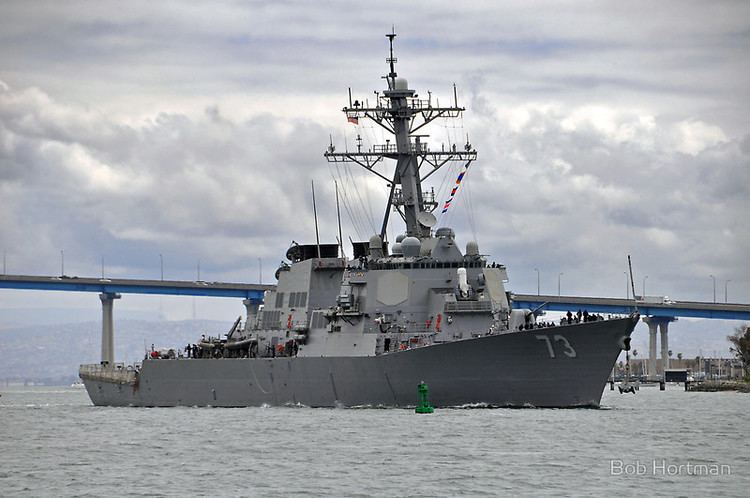
History
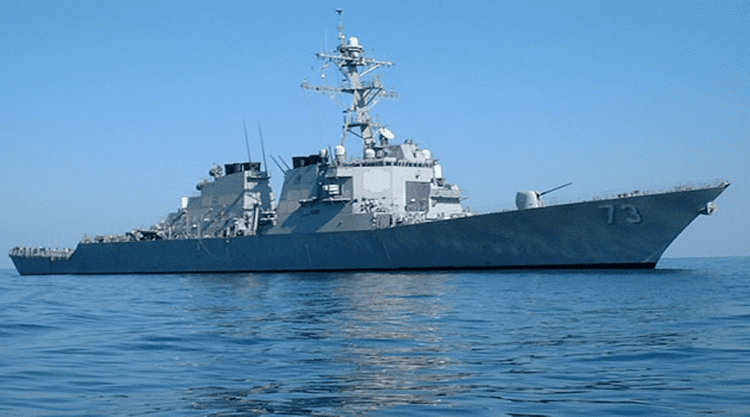
Following a combination shakedown and transit cruise to the west coast, during which Decatur visited San Juan, Puerto Rico; Puerto Vallarta, Mexico she was commissioned on 19 June 1998 in Bath, Maine with the ceremony taking place 29 August 1998, at the Tom McCall Waterfront Park in Portland, Oregon. The guided missile destroyer arrived at her new home port of San Diego on 4 September. She spent the remainder of the year conducting acoustic trials and combat system evaluations. Decatur then spent three months in a post-shakedown availability in the Southwest Marine Yard.
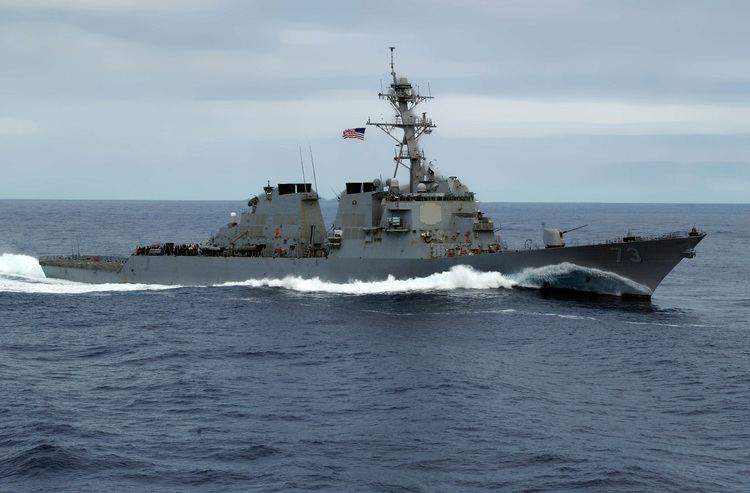
In April 1999, the warship conducted a short cruise to the Northwest, visiting Decatur Island, Washington, and Vancouver, British Columbia, before returning to San Diego in early May. After a second visit to Washington in August, Decatur sent a boarding team of Damage Control Experts to assist MV Gardenia Ace—a car carrier—which had suffered a fire in her engine room.
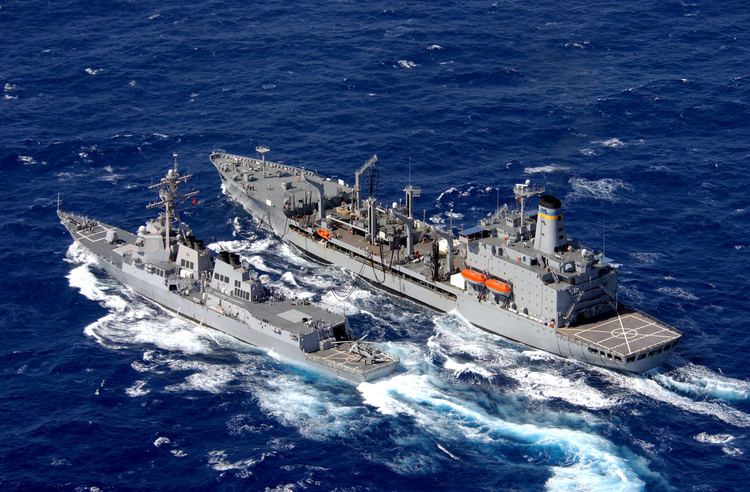
Upon completion of her final missile tests and sea trials, Decatur commenced her first western Pacific deployment on 7 January 2000. After stopping at Pearl Harbor to load Tomahawk land-attack missiles, the guided missile destroyer proceeded to the Yellow Sea for Exercise Sharem 2000—a joint U.S. and South Korean naval exercise—in late January. On 30 January, the warship visited Chinhae, South Korea, and over the next two weeks also stopped at Yokosuka and Nagasaki, Japan. She then sailed south through the Taiwan Strait, made a three-day port visit to Hong Kong, and then commenced a South China Sea exercise with units of the Philippine Navy.
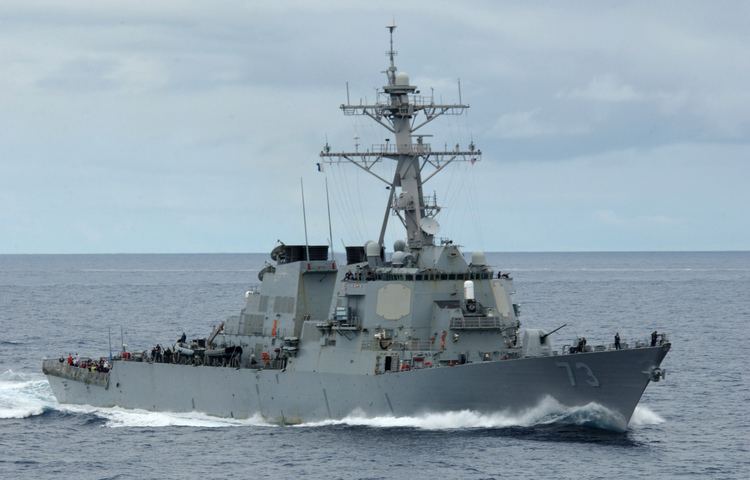
In early March, Decatur visited Malaysia and Guam before sailing south across the Equator to Fiji in April. After visits to American Samoa, and numerous ports in Australia, the guided missile destroyer returned to San Diego on 8 June.

Following upkeep and voyage repairs, the warship operated locally out of San Diego for the rest of the year.
In February 2001, Decatur began various battle group and missile training off the West Coast. Following the terrorist plane hijackings and crashes in New York, Washington and Pennsylvania on 11 September, the destroyer put to sea for Operation Noble Eagle off the coast of the San Francisco Bay Area. Returning to San Diego on 23 September, the warship spent seven weeks preparing for her deployment with the John C. Stennis battle group on 12 November.
The warships steamed west and, after stops at Hong Kong and Singapore, transited the Strait of Malacca on 11 December. Sailing northwest into the Indian Ocean, the battle group joined Central Command's to participate in Operation Enduring Freedom (OEF), in Afghanistan. Decatur remained with the Peleliu Amphibious Ready Group for the rest of the year.
Between 17 December 2001 and 16 April 2002, Decatur escorted the Peleliu Amphibious Ready Group—during which time her security team boarded three merchant ships, including one non-compliant boarding of M/V Francisco Dagohoy on 10 April—in support of Maritime Interdiction Operations. During this period, the warship made three short port visits to Manama, Bahrain. Departing the region on 2 May, the warship sailed for home, stopping in Phuket, Thailand; Bali, Indonesia; Dili, East Timor; Apra, Guam; and Pearl Harbor before arriving in San Diego on 8 June 2002. Decatur spent the rest of the year in upkeep or training out of San Diego.
Decatur departed on its third deployment overall, and second deployment to the Persian Gulf, in August 2003. She made stops in Pearl Harbor and Singapore before arriving in the Persian Gulf. Decatur made a port visit to the Seychelles for four days in November. In December 2003, Decatur seized a 40-foot (12 m) dhow on 15 December, discovering an estimated two tons of narcotics allegedly linked to an al-Qaeda smuggling operation. The drugs had an estimated street value of 8 to 10 million dollars.
In May 2004, Decatur moved dead-stick to dry-dock, its first dry-dock period since construction.
From May through June 2005, Decatur made a series of port visits to the Northwestern United States, including visits to Port Hueneme, Victoria, British Columbia, and the Portland Rose Festival.
In January 2006, Decatur departed for her fourth deployment (third to the Persian Gulf) as part of a Carrier Strike Group, led by the aircraft carrier Ronald Reagan. Throughout the deployment, she conducted Maritime Security Operations in the Arabian Sea and Persian Gulf; participated in three major anti-submarine warfare exercises (including Arabian Shark and Valiant Shield); and as part of the French-led Task Force 473, conducted Arabian Sea operations with the French aircraft carrier Charles de Gaulle. Her port visits were Australia, Malaysia, Bahrain (twice), Oman, Thailand, and Hong Kong. She stopped in Hawaii to pick up civilians for a Tiger Cruise on her return to homeport in July.
On 16 February 2007, Decatur was awarded the 2006 Battle "E" award.
In June 2007, Decatur tested her Aegis Ballistic Missile Defense System by launching a RIM-161 Standard (SM-3). It was the first such test from a US Aegis destroyer.
On 27 May 2008, Decatur departed on her fifth deployment overall, and fourth deployment to the Persian Gulf. She spent a significant amount of time in 7th Fleet, stopping in Hong Kong, Japan and Singapore before proceeding in to the 5th Fleet area for duties. Departing 5th Fleet in September she transited east, stopping in Phuket and Hawaii prior to her return to San Diego in November 2008.
Decatur deployed from May until November, 2009. She visited Guam, Japan, Singapore, Bahrain, Dubai, and Thailand.
On 1 December 2010 Shanti Sethi was promoted from Executive Officer to Commander. She is the 12th female commander in the U.S. Navy.
Up to its disbandment in 2011, the ship routinely deployed with Carrier Strike Group Seven. After that point the ship may have joined Carrier Strike Group 3.
On 26 May 2012 CDR Joel A. Ellingson was promoted from Executive Officer to Commanding Officer of Decatur.
On Tuesday, 2 April 2013, Decatur was sent to the Western Pacific near the Korean Peninsula, to join another destroyer, John S. McCain, in response to growing threats and an increase in belligerent statements and actions by North Korea's leadership, which were made following the beginning of a joint U.S.-South Korean military drill operation and also as a result of new sanctions which were issued after it launched a rocket and then tested a nuclear bomb underground. Among these new threats were: the planned re-activation of the Yongbyon nuclear reactor, the closure of the Kaesong Industrial Region along the border, a declaration that the armistice that ended the 1950s Korean War was invalid, the disconnecting of an emergency hotline to the South's leadership—perhaps the last direct communications link to the South—and putting missile batteries on standby mode to potentially strike South Korea and/or U.S. bases in Okinawa, Japan and the Pacific). A third warship, Fitzgerald, was also made available, and radar was deployed to the area. As a show of force and as part of the drills, the U.S. sent bombers and other aircraft (including the B-2 stealth bomber, capable of carrying conventional or nuclear weapons), to the region, and both South Korea and the U.S. pledged to vigorously defend themselves.
Commanding officers
The Commanding Officer (CO) of USS Decatur (DDG-73) is the most senior officer that is in command of the ship. Sailors will refer to the CO as "the Captain" (regardless of rank), or sometimes informally as "Skipper". Below is the list of commanding officers of USS Decatur.
Shield
The shield has background of dark blue. In the center is a red crown. Crossing in the center of the crown is an English officer’s sword and a seax.
The traditional Navy colors were chosen for the shield because dark blue and gold represents the sea and excellence respectively. The seax signifies a series of victories by Stephen Decatur over sea forces of North African terrorist nations. The English officer’s sword symbolizes Decatur’s victory over HMS Macedonian during the war of 1812 in one of the greatest single ship actions of naval history. The celestial crown symbolizes anti-air warfare capabilities. The crown has five mullets for each of the ships named Decatur. It also represents Stephen Decatur’s engagements against the British during the war of 1812. The color gold represents excellence, while scarlet denotes courage and sacrifice.
Crest
The crest consists of a ship’s mast and sail with a flying pennant.
The ship’s mast and sail represent the heritage of the Decatur name and the Navy of Stephen Decatur’s time, with the first vessel to bear his name. The mast is also in reference to the traditional pine construction of the vessels of Decatur’s Navy times. The pennant is to symbolize the senior naval authority which was earned by Commodore Stephen Decatur.
Motto
The motto is written on a scroll of white that has a blue reverse side.
The ships motto is "In Pursuit of Peace".
Seal
The coat of arms in full color as in the blazon, upon a white background enclosed within a dark blue oval border edged on the outside with a gold rope and bearing the inscription "USS Decatur" at the top and "DDG 73" in the base all gold.
